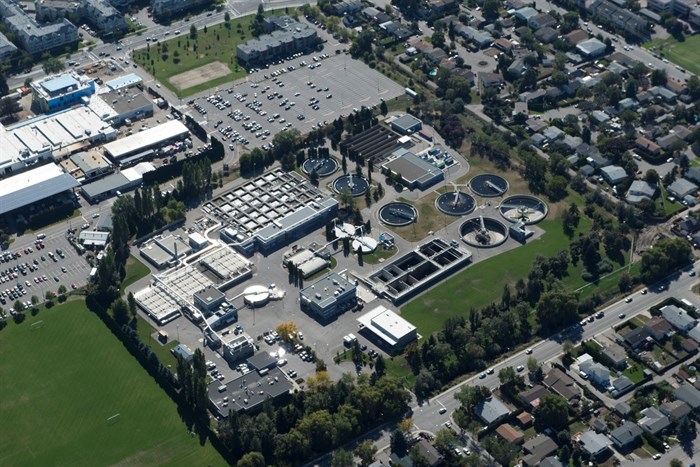This Okanagan city's rapid growth means expensive fixes for sewage treatment down the road

With Kelowna being the fastest growing of Canada’s largest cities and with another 45,000 more people expected by 2024, there’s lots of talk about building heights and gridlocked streets. But will residents still be able to flush their toilets and get drinking water from their taps?
The answer, on both fronts, is mostly yes.
The city’s sewage (wastewater) treatment plant can process 70 million litres a day and is only handling 25 to 35 million these days.
Its water intake at Poplar Point on Okanagan Lake is near capacity at 90 million litres per day. The Cedar Creek intake is handling about half that volume but has room to grow to 90 million litres per day as well.
There are bottlenecks in the system that will require some expensive fixes in the coming years, including a possible $78 million anaerobic digester at the sewage treatment plant.
“The volume coming to the plant isn’t growing as fast as the population because, as new buildings are built and existing buildings are renovated, they’re using less water,” Kevin Van Vliet, the city’s utility services manager, told iNFOnews.ca. “We’re putting in low-flow fixtures and everything else. What we’ve actually been seeing is the amount of nutrients coming into the plant is growing with the population. The flow is not.”
In other words, there’s more poop flushed down city toilets but less water used to transport it per flush.
The treatment plant processes the raw sewage and ships the sludge (wastewater solids or biosolids) to a composting site in Vernon that it shares with that city.
That material is turned into OgoGrow, a Class A compost. That means it’s fit to use in parks, home gardens or by compost suppliers who may mix it with their own products.
The problem is, there's too much OgoGrow.
The problem was identified six or seven years ago, galvanizing city staff to look into alternatives.
Since last year, some of the waste material is being shipped to a composting site in a mine near Princeton, buying the city more time to explore options.
Soon there will be another mine near Princeton composting biosolids along with another facility expected to open soon in the old Brenda Mine site above Peachland.
READ MORE: How Okanagan and Nicola organic waste can be processed closer to home
Having those options allows both cities time to study the benefits of an anaerobic digester before spending big bucks on it. Currently that’s projected to be done in 2030.
Part of that research is to figure out who and what will use the digester. That could include sludge from the West Kelowna treatment plant, the SunRype plant in Kelowna’s North End and/or fats, oils and greases that are currently shipped to the Lower Mainland, Van Vliet said.
The digester reduces the volume of the waste by 50% and it can be used, under provincial permits, on farm or forest lands without composting, or it too can be turned into OgoGrow.
While the treatment plant still has lots of capacity, the city has bought land off Burtch Road for a future sewage treatment site.
Van Vliet can’t say whether that will be a brand new facility to replace the existing one next to Okanagan College, or a satellite operation.
“It won’t be my problem,” Van Vliet said. “It will be my grandkids’ problem to figure out, or my children’s problem near the end of their working careers.”
On the water side of things, the northern part of the city and downtown reaching towards KLO Road are fed by the Poplar Point plant using two reservoirs on Knox and Dilworth mountains.
While the reservoirs are adequate in size, the capacity of pipes to move the water to Dilworth Mountain is limited.
That means, at some point, new pipes will have to be installed under city streets.
Existing pipes last from 50 to 100 years so are normally replaced at that time and oversized to cope with future growth.
It’s too early to say what street might be dug up for that work but it will not be where the current line is along Royal Avenue, running along the south side of Knox Mountain.
City council agreed earlier this week to spend $5.35 million to “rehabilitate” the slope below Royal Avenue that has been failing off and on for years. Not only does that threaten Knox Mountain Metals at the foot of the mountain but the water and other utility lines (natural gas, sewer, electrical) running along Royal Avenue.
Right now, the two water systems are not well connected but, as the downtown area grows and needs more water from Poplar Point, the Cedar Creek plant will gear up pumping capacity and connections will be improved.
The reservoir for the southern end of the city and South East Kelowna is in the Kettle Valley area.
The City of Kelowna provides water for more than half its residents while the rest get their water from Glenmore, Black Mountain and Rutland irrigation districts.
To contact a reporter for this story, email Rob Munro or call 250-808-0143 or email the editor. You can also submit photos, videos or news tips to the newsroom and be entered to win a monthly prize draw.
We welcome your comments and opinions on our stories but play nice. We won't censor or delete comments unless they contain off-topic statements or links, unnecessary vulgarity, false facts, spam or obviously fake profiles. If you have any concerns about what you see in comments, email the editor in the link above.



